The first storage-type hot water heater unit is believed to have been invented by Edwin Ruud, all the way back in 1889. That specific unit allowed water to be heated, as well as stored, in a metal tank until it was needed. Naturally, things have evolved, and the first iteration of the water heater is seen as inefficient and bulky. This is because the traditional tank models are limited by the amount of water that they can hold.
On top of that, we also have the fueled and electric models of tankless water heaters. Today, we’ll be taking a look at the best electric tankless water heaters. It is believed that these do not receive the credit that they deserve and are – in some cases – better than their fueled counterparts. Before introducing you to an extremely comprehensive buying guide, let’s analyze some electric tankless water heater reviews and possibly help you find the right fit for your home and needs.
Best Electric Tankless Water Heaters Comparison Chart
| PRODUCT | DETAILS | ||
|---|---|---|---|
 | Stiebel Eltron 15 Trend Tempra, Tankless Water Heater |
| View On Amazon |
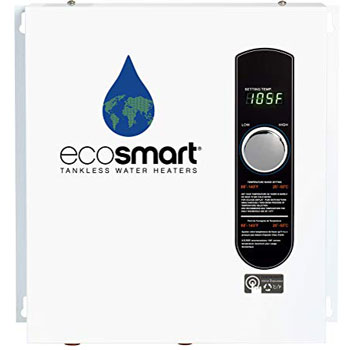 | EcoSmart ECO 27 Electric Tankless Water Heater |
| View On Amazon |
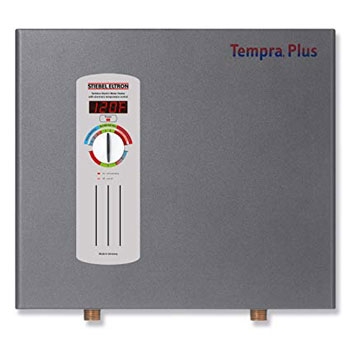 | Stiebel Eltron Tempra 24 Plus Whole House Tankless Electric Water Heater |
| View On Amazon |
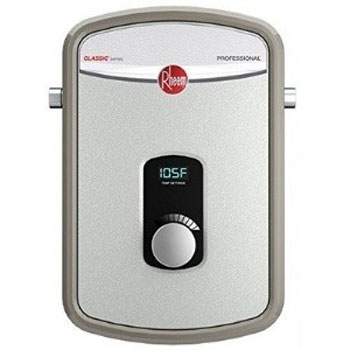 | Rheem RTEX-13 Residential Tankless Water Heater |
| View On Amazon |
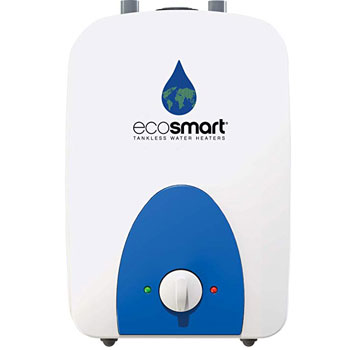 | EcoSmart ECO MINI 2.5 120V Electric Mini-Tank Water Heater |
| View On Amazon |
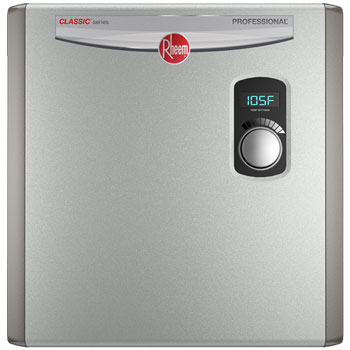 | Rheem RTEX-24 Residential Tankless Water Heater |
| View On Amazon |
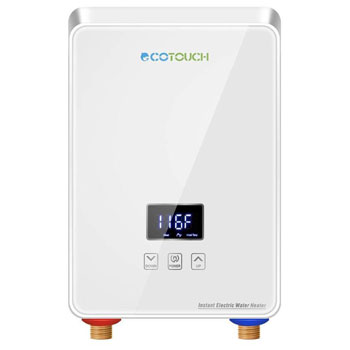 | ECOTOUCH Electric Point-of-Use Hot Water Heater |
| View On Amazon |
Electric Tankless Water Heater Reviews – Top-Picks
1. Stiebel Eltron 15 Trend Tempra, Tankless Water Heater
 This tankless water heater from Stiebel Eltron comes with a 4.5-star rating and with over 600 customer reviews. The body of the heater itself features a sleek design that saves spaces – since there’s no venting required.
This tankless water heater from Stiebel Eltron comes with a 4.5-star rating and with over 600 customer reviews. The body of the heater itself features a sleek design that saves spaces – since there’s no venting required.
The product also features digital displays that ensure accurate temperature delivery, as well as maximum energy efficiency. You can also make use of the pre-set temperature buttons on the Plus models of this product in order to access the temperature memory settings.
The Advanced Flow Control technology helps this product maintain hot water temperature automatically, for continuous comfort. No matter the type of water demand in your home, it is stated that your shower will always stay hot!
Pros:
- Energy saving
- Entirely silent operation
- A small and compact unit
- Engineered in Germany
- 7 years of leakage warranty
- 3 years complete parts warranty
Cons:
- Reportedly, the product is very hard to install, and one couldn’t do it by themselves.
- Relatively low GMP output – roughly 3 GPM.
2. EcoSmart ECO 27 Electric Tankless Water Heater
 The second product on our list, the EcoSmart ECO 27, has a 4-star rating and more than just enough reviews, so to say. Right of the bat, the manufacturer claims that you can save up to 50% on water heating costs.
The second product on our list, the EcoSmart ECO 27, has a 4-star rating and more than just enough reviews, so to say. Right of the bat, the manufacturer claims that you can save up to 50% on water heating costs.
In terms of features, the heater comes with digital temperature control, in 1-degree increments, which allow you to efficiently control the hot water. The activation flow of this specific unit is 0.3 GPM.
The insides of this product are made from stainless steel and copper, ensuring durability, efficiency, as well as ease of replacement. The dimensions are 17H, 17W, and 3.625D, making the unit compact and helping you save space within your home.
Pros:
- You can save up to 50% of water heating costs
- Digital temperature control
- Limited lifetime warranty
- Self-modulating technology
- Ease of replacement when it comes to parts
Cons:
- Unable to produce piping hot water at high flow rates
- Some customers reported that, when the heater operates at medium to high power, the house lights may flicker a little, but will stop immediately after.
3. Stiebel Eltron Tempra 24 Plus Whole House Tankless Electric Water Heater
 Yet another Stiebel Eltron product on our list – it’s only natural, given that this manufacturer is one of the more popular when it comes to electric tankless water heaters.
Yet another Stiebel Eltron product on our list – it’s only natural, given that this manufacturer is one of the more popular when it comes to electric tankless water heaters.
This particular model comes with digital temperature control, as well as proven reliability. On top of that, the Tempra-labeled models are said to give constant energy savings as the heaters equipped with this technology are on only when you need hot water. Reportedly, they have no standby losses.
The heating chambers of the water heater are made of solid copper, to minimize heat loss, while the Advanced Flow Control technology keeps the temperature constant. This interesting piece of tech is able to slightly reduce the water flow when the hot water demand exceeds the heater’s capacity. Obviously, this will maintain the liquid’s constant temperature.
Pros:
- Continuous hot water
- Digital temperature display
- Advanced Flow Control technology
- Auto-modulation feature that saves energy
Cons:
- It requires a sediment filter before installing the unit
- Some users complained of its low GPM output, stating that you can enjoy hot water from a single faucet at a time.
4. Rheem RTEX-13 Residential Tankless Water Heater
 One new manufacturer entry to our list is this water heater from Rheem. This particular product features external adjustable digital thermostatic control with a LED display, with quite a high accuracy.
One new manufacturer entry to our list is this water heater from Rheem. This particular product features external adjustable digital thermostatic control with a LED display, with quite a high accuracy.
The power control is self-modulating and the two heating elements are based on durable copper immersion. The product is also field serviceable – so, you don’t have to worry about uninstalling it in case something goes wrong.
Moreover, the installation is pretty simple. The package comes with everything you need: a 3-feet electric cable, ½ NPT adapters included, as well as side ½ inch compression water connections. This residential tankless water heater comes with 99.8% energy efficiency and with a water-saver shower head feature that runs on 1.5 GPM.
Pros:
- Threaded unit – easy replacement and installation
- Two heating elements.
- Durable copper immersion
- 99.8% energy efficient
- External adjustable digital thermostatic control
Pros:
- The package may come without a power cord or mounting screws.
- Some customers stated that it is a bit power-hungry since it requires a 60-amp service.
5. EcoSmart ECO MINI 2.5 120V Electric Mini-Tank Water Heater
 This product from EcoSmart comes with a design fitted for its name – compact and sleek, meant to fit almost anywhere within your house.
This product from EcoSmart comes with a design fitted for its name – compact and sleek, meant to fit almost anywhere within your house.
The water heaters of the ECO MINI series are said to be 99.8% energy efficient. Judging by the number of positive reviews and by the fact that this model is Amazon’s Choice in terms of small water heaters, we can assume that to be true.
Reportedly, this water heater is pretty easy to install and doesn’t require a lot of know-how – just a little bit of intuitive knowledge. It is manufactured in the United States, has an amperage capacity of 12 A, and runs on 120V.
Pros:
- Sleek and compact design
- 99.8% energy efficient
- 5 years limited warranty on leaks and 1 year on parts
Cons:
- You may need additional screws, extender fittings, as well as an extra ½’’ to ½’’ line.
- Moreover, the user’s manual doesn’t seem to give any instructions in terms of any required hoses or fittings.
6. Rheem RTEX-24 Residential Tankless Water Heater
 Yet another product from Rheem, as well as another Amazon’s Choice on our list, the RTEX-24 model features an external digital thermostatic control unit with a LED display. The product is also equipped with what is reportedly the most advanced self-modulation technology, which allows you to adjust power in order to meet the demand for hot water.
Yet another product from Rheem, as well as another Amazon’s Choice on our list, the RTEX-24 model features an external digital thermostatic control unit with a LED display. The product is also equipped with what is reportedly the most advanced self-modulation technology, which allows you to adjust power in order to meet the demand for hot water.
Unlike the previous Rheem product, this one comes with three heating elements based on durable copper immersion. As expected, the installation is very simple, as the bottom of the water heater features ¾ inch NPT water connections.
Furthermore, this model is also threaded, ensuring ease of replacement and installation. It has a flow rate of up to 5.9 GPM.
Pros:
- Self-modulation
- 3 heating elements
- Simple installation
- Up to 5.9 GPM flow rate
Cons:
- This is a single faucet use water heater – meaning that hot water can run through one faucet at a time.
- The unit may also need a reduced inline – from ¾ to ½ so that the heater can reportedly keep up. Be sure to take this into consideration when installing this product.
7. ECOTOUCH Electric Point-of-Use Hot Water Heater
 The last product on our list is the ECOTOUCH electric tankless water heater. Featuring a 5.5kW heating system, the unit can supply you with instant, endless, and consistent hot water of 116 F or higher.
The last product on our list is the ECOTOUCH electric tankless water heater. Featuring a 5.5kW heating system, the unit can supply you with instant, endless, and consistent hot water of 116 F or higher.
Reportedly, you don’t need to wait for the water to preheat or to adjust it until it gets to the right type of hot.
In addition, this water heater comes with a smart self-adjustment. This means that the product will adjust its power based on the water’s flow rate and the temperature setting – all of this in real-time. When the water flow is reduced, for example, the heater will apply less power.
Because of this, you will still get the ideal water temperature without having to bear with scalding hot water.
Pros:
- 5.5kW heating system
- Smart self-adjustment
- Digital display and touch control panel
- Designed to avoid leakage or scale build-up
- Extremely compact due to the unit’s sleek design
- It can be mounted in any way, direction, and degree possible
Cons:
- Some users stated that hot water pressure may significantly drop once in a while
What Is an Electric Tankless Water Heater?
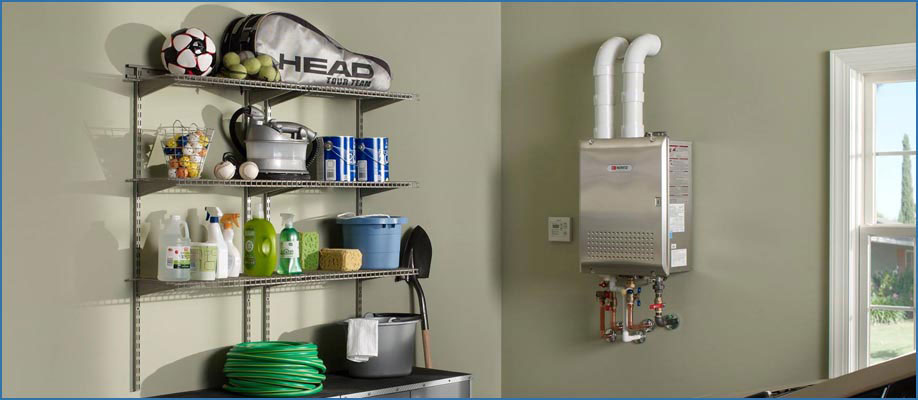 An electric tankless water heater is, as you may easily deduce, a water heater that runs on electricity and doesn’t need a tank to store water. Basically, it is able to provide you with hot water only when you need it.
An electric tankless water heater is, as you may easily deduce, a water heater that runs on electricity and doesn’t need a tank to store water. Basically, it is able to provide you with hot water only when you need it.
On top of that, such heaters do not produce standby energy losses that usually come with the traditional, storage water heaters. This will, obviously, save you money.
Electric tankless water heaters start working when a hot water tap is turned on. In such a moment, cold water will travel through a pipe and into the heater’s unit. In our case, an electric element will then heat the water.
Therefore, tankless water heaters are able to deliver residents a constant supply of hot water. There is no need for you to wait for a tank to fill up with the hot water that you need.
Even though the output of a tankless water heater limits the flow rate, it goes without saying that such products have indeed changed the definition of on-demand type water heaters.
How Efficient Are Electric Tankless Water Heaters?
Reportedly, the normal thermal efficiency of an electric tankless model is around 78 to 85%. A high energy-efficient model can save you up to 60% in energy costs every single month. Of course, heating bills will also be saved to a large extent.
On top of that, it is said that tankless models use 30 to 50% less energy than the traditional tank units, mainly because they heat water only when you actually need it. It was shown that the usual family is able to save roughly $100 – or even more – on energy costs per year.
There is no doubt that electric and tankless models are efficient. First of all, the tankless models clearly have the upper hand in terms of efficiency, as the heater’s unit does not have to store the water.
On top of that, even though it’s more expensive, electricity will save you money in the long run as there’s not much of it that goes to waste. If you remember, most of the models that we reviewed used up to 98.9% of the energy that they were fed with to actively heat water.
Electric Tankless Water Heaters Buying Guide
Now, we’ve prepared for you a very comprehensive guide that will most likely help you make the right decision when it comes to buying an electric tankless water heater. If the products we’ve reviewed earlier didn’t interest you that much, then you can keep on reading and find out how you can search for a tankless water heater on your own. Therefore, without any further ado, let’s see what you should know about electric tankless water heaters.
What Should You Consider When Buying an Electric Tankless Water Heater?
When it comes to buying an electric tankless water heater, there are a couple of things that you should consider. However, on top of it all is understanding the hot water needs of your household. This means that you shouldn’t go for the cheapest or for the most power-hungry water heater out there, especially if you know that you either need a lot of hot water or if you live alone. Buying such appliances involves analysis and proper decision making. Pay attention to this when buying water heaters and not only!
Let’s skip to the important part and see what you should ask and consider when buying an electric tankless water heater, besides the hot water demand. Meanwhile, we will compare electric tankless water heaters to gas tankless water heaters.
Installation
It is well known that electric tankless water heaters are less expensive than their gas-powered counterparts. For example, a quality model can be bought for around $600.
However, keep in mind that there are homes that are not built to provide the water heater with the electrical requirements that it needs to operate. Installing an electric tankless water heater in such a home will increase the installation expenses – upgrading the house’s electrical system is not cheap.
Lastly, since there are no exhaust gases produced by an electric unit, you won’t have to install any venting in your home. Moreover, you can install the electric water heater wherever you want in your home!
Design
Most electric tankless water heaters come with a rather simplistic design. Such units may not look appealing for some of you, but the fact that they are easier to troubleshoot is worth the lack of style.
In fact, you could troubleshoot, diagnose, and repair an electric tankless unit on your own. This also makes an electric unit have a longer service than a gas tankless water heater.Electric models are also very small. As you’ve seen in our review section, they even come in mini models that can fit anywhere. Usually, electric systems are about the third the size of gas systems.
Efficiency and Costs
They are known to be extremely energy efficient. Most of the units we have reviewed use over 98% of the electricity they receive to heat the water. This means that no power is lost – never.
On the other hand, keep in mind that electric units do require a substantial amount of energy to operate. As mentioned above, if your home is not fit to supply this device with the power it needs, you will have to upgrade your electrical system. The very good thing about electric tankless water heaters is that these products do not produce greenhouse gases. In short, you have on-demand hot water brought to you in an environmentally friendly way.
Water Flow
Naturally, you will want the water heater to have a water flow big enough to satisfy all your needs. In this respect, you may choose between single-use and whole-house heaters.
A whole-house heater is able to provide constant hot water for kitchen and bathroom faucets at the same time. For example, the average flow rate of a water heater in the whole house type should be around 3 to 8 gallons per minute. On the other hand, single-use gallons are fit for smaller families or for people living alone, as they are capable of providing hot water to a single faucet at a time.
Safety
You won’t buy a certain water heater just because it is able to heat your water. You will choose one depending on the features it comes with – among the convenient features, you will also have a series of safety features that you have to take into account.
For example, most electric tankless water heaters come with self-protection systems such as freeze protection, temperature lock, self-modulating technology, and so on.
Warranty
In terms of the warranty, you can get one that protects you from leaks and one for part failure. For example, one of the models we’ve reviewed earlier came with 7 years leakage warranty and with 3 years part warranty.
You have to understand that such a product is going to be used for more than just a couple of years, given the price that they come with. A long – as well as trustful – warranty, can save you a lot of money in repairs and maintenance. As a guideline, remember that the average heat exchanger warranty is usually from ten to 12 years.
The Most Important Features of Electric Tankless Water Heaters
 Now that you know what you should consider when buying such a product, let’s take a look at some of the most important features and specifications of an electric tankless water heater.
Now that you know what you should consider when buying such a product, let’s take a look at some of the most important features and specifications of an electric tankless water heater.
Flexible Installation Spots
These units can be installed anywhere you want, as long as you have where to plug them in.
Fast Heating Time
You need to wait for a maximum of one minute for your hot water. Naturally, some systems are capable of providing you with instant hot water.
Less Powerful than Gas Systems
Obviously, an electric system of any kind is always sub-par when compared to its gas counterpart. Thus, electric water heaters require more electricity to operate and the costs may be a little higher as well.
True On-Demand Heating
With a tankless system, you will enjoy hot water every single time you open your faucet.
Maximum Energy Efficiency
As mentioned above, electric tankless water heaters are believed to use 98% and, in some cases, even up to 99% of the energy they consume in order to heat water.
Disease Protection
The fact that a water heater is tankless means that you won’t have a tank full of stagnating water in your house. Such water is susceptible to bacteria build-up.
How to Properly Size an Electric Tankless Water Heater
As with most home appliances, sizing is a very important step in the buying process. If you fail to properly size an appliance, then you will most likely have to return it. The latter process may become quite difficult if you order the product online. Therefore, before buying an electric tankless water heater, you will have to size it for your home’s hot water needs.
To do so, you will need the help of two calculations. Once you know the results, you will have no issue in finding a product that’s perfectly sized for your home and family.
- Temperature Rise – this is the difference between the temperature of the incoming groundwater and the heated output temperature.
- Flow Rate – this is the amount of water that a tankless water heater can heat at any given time. The flow rate is measured using GPM – gallons per minute.
Now, it is time to move on to the actual sizing process, as it follows.
Peak Demand
First, you will need to round up your home’s peak demand flow rate. For this, you have to determine when your family uses hot water the most. Most families have their peak demand in the morning when everybody wakes up, showers, shaves, boils coffee, and so on. Keep in mind to calculate the GPM of each hot water appliance that you will use and take the values into account when calculating the peak demand – in short, add them up!
Temperature Rise
In order to determine the temperature rise, you have to subtract the temperature of the groundwater from the output temperature that you desire. For example, if the temperature of the groundwater is around 50 degrees and you want the output temperature to be 120 degrees, then the temperature rise will be 70 degrees. Calculating this will let you know how powerful the heater should be.
Buy the Heater
Given that manufacturers actually use Temperature Rise and Flow Rate as terms to advertise their tankless heaters, it will be very easy for you to find the one that fits your needs the best. Just make sure that you calculate the above-mentioned values properly and don’t make any mistakes!
Read our article to learn how water heater heat traps work, too!
Types of Electric Tankless Water Heaters
 Whole-House Electric Tankless Water Heaters
Whole-House Electric Tankless Water HeatersIn a day-to-day situation, your family will most certainly need hot water to shower and do the dishes in the morning – or in the evening. In this scenario, you need to be able to provide every faucet in your home with instant hot water.
To do so, you will need a so-called whole-house water heater. Such a product is basically a system that meets all your hot water demands for the entire house. However, you have to take into account the size of your home as well. For example, three or four bathrooms will require a large flow type heater, while homes with one bathroom will do just fine with a small flow type.
Point of Use Electric Tankless Water Heaters
Single points of application or single rooms will manage just fine with a single-use unit. Just as the name implies, these are small heaters that are perfect for providing a single faucet at a time with hot water. They are efficient, eliminate standby heat loss almost entirely, and are easy to install. For example, you may need up to 4 single-use heaters to meet the hot water demand of a home with three bedrooms.
Portable Electric Tankless Water Heaters
Portable units are very light and have a significantly smaller flow rate – compared to whole house units, for example. The advantage is that they can be carried and installed wherever you want.
Naturally, such units are ideal for traveling and camping – they can also be installed within an RV.Outdoor Electric Tankless Water Heaters
These are usually installed on the outside wall of the bathroom and come with freeze protection systems. Some units may also feature an enclosure – rain cap – in order to lengthen the service of the product as much as possible. Outdoor heaters are ideal for homes that don’t have enough space available or don’t wish to fill it with a heater.
The Pros and Cons of Electric Tankless Water Heaters
Naturally, electric tankless water heaters come with both pros and cons. Let’s see some of them.
Pros
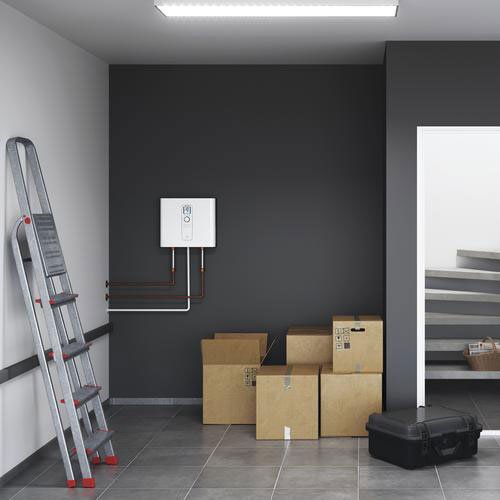
- Support Constant Hot Water – we’ve mentioned this a lot of times; the simple fact that you get access to instantly hot water is the best thing that an electric tankless water heater comes with.
- Energy Efficient – most units on the market can save up to 60% in energy costs compared with a tank storage water heater.
- Environmentally Friendly – no greenhouse gas emissions.
- Space Saver – most units come with a sleek and compact design.
- Easy to Install – no need for venting kits; you can install the unit indoors, outdoors, or anywhere you want or need to.
- Longer Lifespan – traditional, tank units have a lifespan of roughly ten to fifteen years. On the other hand, tankless units can last more than 20 years.
- Reduced Risk of Water Damage – obviously, tanks are prone to leaks and bursts. A burst, for example, can damage the property and cause more damages than it would take to buy five or more tankless models. Even though tankless units can also leak, they will definitely not flood your home.
Cons
- Low Water Flow – obviously, a natural gas tankless water heater has more power than an electric one. For example, a couple of electric models are on par with a single gas model.
- Upfront Cost – the initial cost of a tankless unit is usually higher when compared to tank units, as the former requires a dedicated sealed vent system.
The Costs that Come with an Electric Tankless Water Heater
When it comes to the costs of an electric tankless water heater, you have to take into account the price of the unit itself and then the costs of using and maintaining the product.
Therefore, you will most likely have to deal with the following costs:
Initial Price
Electric tankless models are much cheaper than gas tankless models. However, as mentioned above, they are not cheaper than their tank counterparts. On top of that, given that most electric models are designed for point-of-use, the power they use and their flow rate are not so large in order to justify a bigger cost. As a result, most electric tankless water heaters are under $1000, with an average price of around $600.
Other Costs
On the other hand, the installation, maintenance, and heating costs of an electric tankless water heater are higher than those of gas tankless heaters. This is mainly because, if you are not a professional, you will have to call someone to install your electric heater and then handle its (annual) maintenance. When it comes to heating costs, it is well known that electricity costs more than natural gas – and you will need quite some power to keep an electric tankless water heater running, unlike a gas tankless water heater.
Electric Tankless Water Heaters – Installation & Maintenance
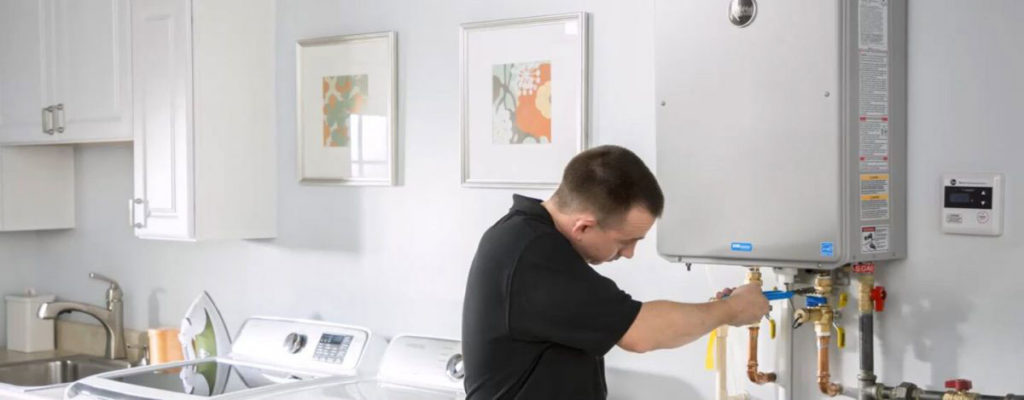 Even though most manufacturers claim that their product is easily installed, it does take more than a couple of screws and a plug to install an electric tankless water heater.
Even though most manufacturers claim that their product is easily installed, it does take more than a couple of screws and a plug to install an electric tankless water heater.
You have to pay attention to what you are doing and follow the user’s guide carefully. Therefore, let’s take a look at how most electric tankless water heaters are installed – it’s not as easy as replacing the salt for water softeners.
Installation
- Most models can be installed indoors only. You can install a model both indoor and outdoor only if the manufacturer allows and specifies it. However, outdoor-installed units should be enclosed to avoid weather damage.
- For indoor installation, it is better if the electric tankless water heater is installed near the main power panel or application fixture.
- Keep in mind that the distance between the tap and the heater determines how long you will have to wait for your hot water. Longer waiting times will increase your water bill. In short, an installation near the point-of-use of the heater will ensure instant hot water.
- On top of that, if you install the unit far away from the faucets or the power panel, you will need to deploy more tubes and wiring.
- If you decide to install the electric tankless water heater in the bathroom, you have to make sure that the showerhead is at a safe distance from the unit. Ensure the fact that the heater will not get water on it.
- It is also recommended that you install it in an area where ventilation is present, and moisture is not.
- The electric tankless water heater should also be positioned in an easy-to-access area. You should be able to easily reach and operate the unit.
- Lastly, always follow the instructions manual and safely use the heating machine. Obviously, make sure that nothing is covering the heater.
Since the installation of an electric tankless water heater will be described in the user’s manual, we decided to provide you with some useful tips rather than tell you how to attach the unit to the wall.
Maintenance
Tankless water heaters can, in fact, accumulate minerals that can then build-up on the heating chamber’s walls and erode them. Therefore, you will have to maintain your tankless heater. You will do so by flushing and removing the mineral deposits within the unit at least once a year. Here’s how to do it:
- Turn off the power source by turning off the circuit breaker for electrical devices.
- Close and then turn off the three water valves that are attached to your electric tankless water heater.
- Then, you have to slowly remove the purge port valve caps from the purge valves that are located on each of the hot and cold-water valves.
- Attach hosing lines to each of the three valves.
- Open the purge port valves – with a perpendicular twist to the position of the hot and cold valves.
- Use around 2.5 gallons of undiluted white vinegar in order to clean the water heater. Avoid using chemical solutions.
- The flushing and draining procedure should be done according to the directions provided by the heater’s manufacturer.
- Then, you will have to close the purge port valves – with a twist of the T-shaped valves.
- Disconnect and remove the hosing lines.
- Replace the caps of the purge port valves.
- Read the user’s manual and search for instructions on how to safely restart your heater.
- Lastly, turn on your sink’s hot water tap, allowing some air to pass through the piping.
Learn about how to get rid of air in your how waterline, too.
Frequently Asked Questions
- Do I need special faucets for an electric tankless water heater?
No, you do not. Tankless units are known to work the best when they use water-saving faucets that have aerator screens built-in. These screens usually run at a flow rate of one to two GPM. So, you can use them in your regular bathroom. - What is the biggest benefit of an electric water heater?
When it comes to electric heaters, they are known to use almost all of the energy they consume to actively heat your water. Second of all, they can save you up to 60% on energy costs. - What is the biggest benefit of a tankless water heater?
Tankless water heaters imply that you have available an endless source of hot water. Tank models heat the water inside a tank and then store it there for later use. When you consume all the water in the tank, you will have to wait for your tank heater to heat up some more. Tankless water heaters will supply you with water for as long as you have a water supply and it keeps on providing your house with water. - Will this device work on my home’s current electric system?
In most cases, electric tankless water heaters come with expensive and substantial upgrades to your home. For example, there are models that have four elements of 7,000 watts each – making up for a total electrical load of 28 thousand watts. This additional load will require at least 120 amps. Given that the average home comes with a total capacity of 200 amps, this means that you will have to upgrade your electrical system.
Wrap Up
As you can see, electric tankless water heaters seem to be the ideal solution to on-demand hot water. Since we’ve provided you with some electric tankless water heater reviews, we hope that we’ve been of some help in your journey through these heaters’ world.
On top of that, if you keep in mind everything that we’ve mentioned in our buying guide, you will certainly find some of the best electric tankless water heaters out there. And, after finding them, the last thing for you to do will be to choose the one to fit your needs, your home, and your demand for hot water!
Please visit WaterFilterMag for under sink water filter reviews

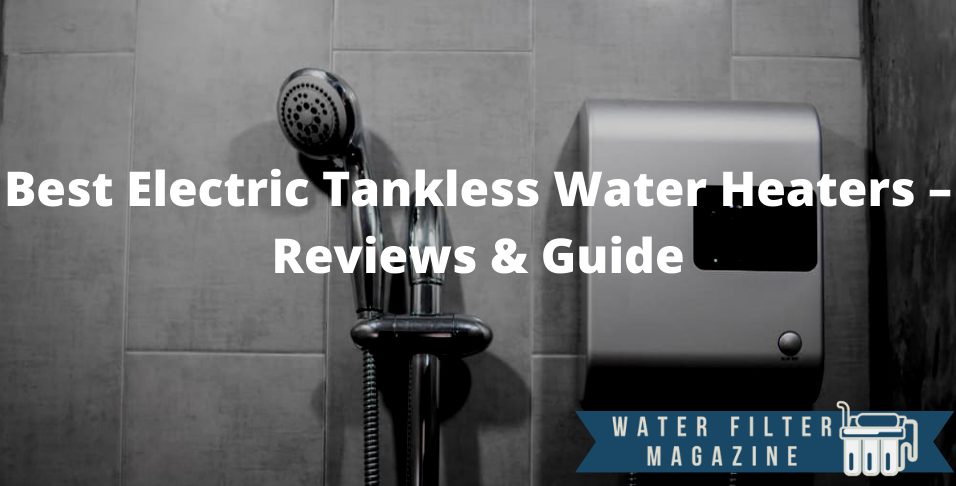
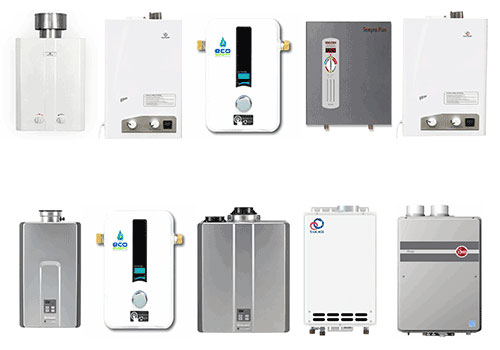 Whole-House Electric Tankless Water Heaters
Whole-House Electric Tankless Water Heaters